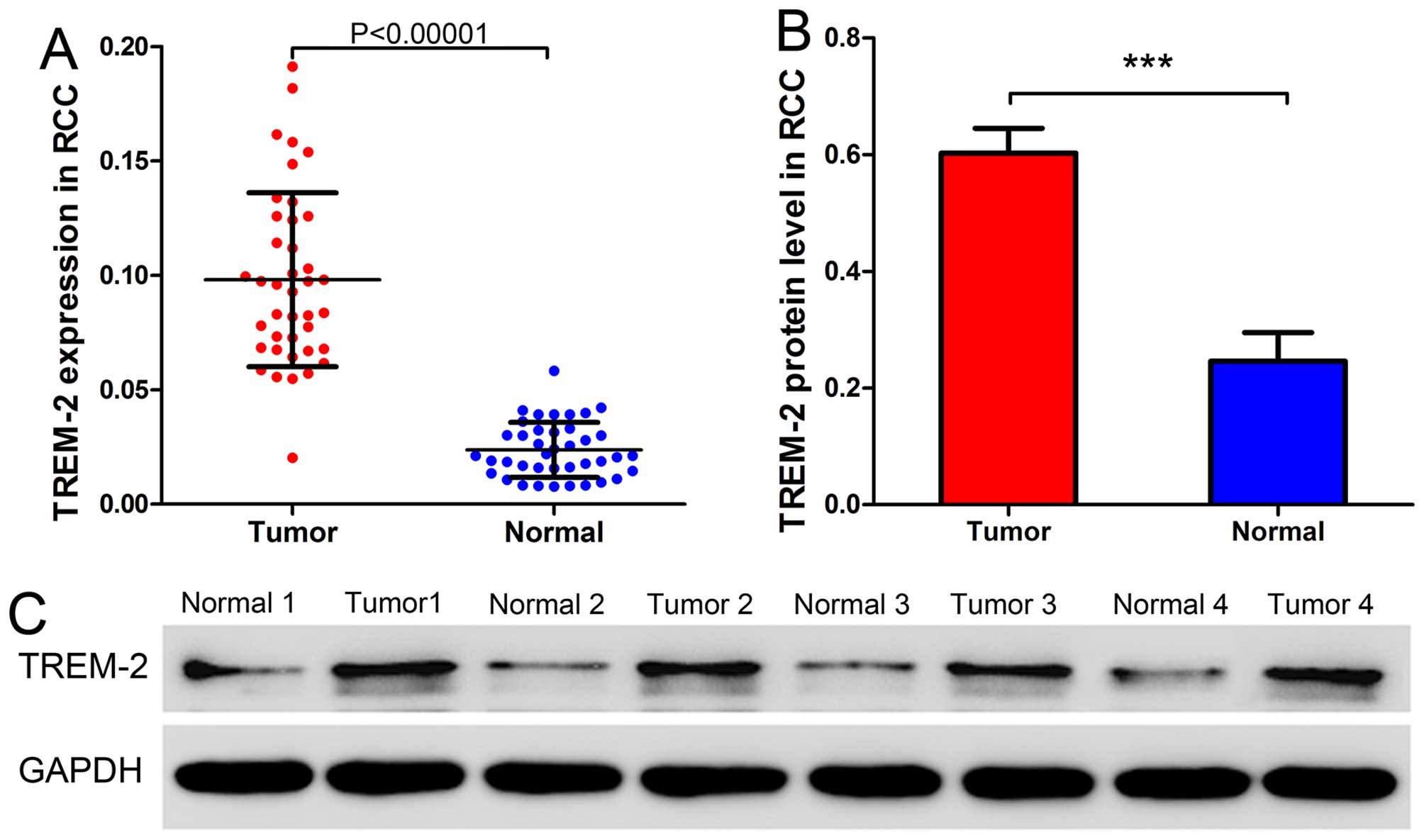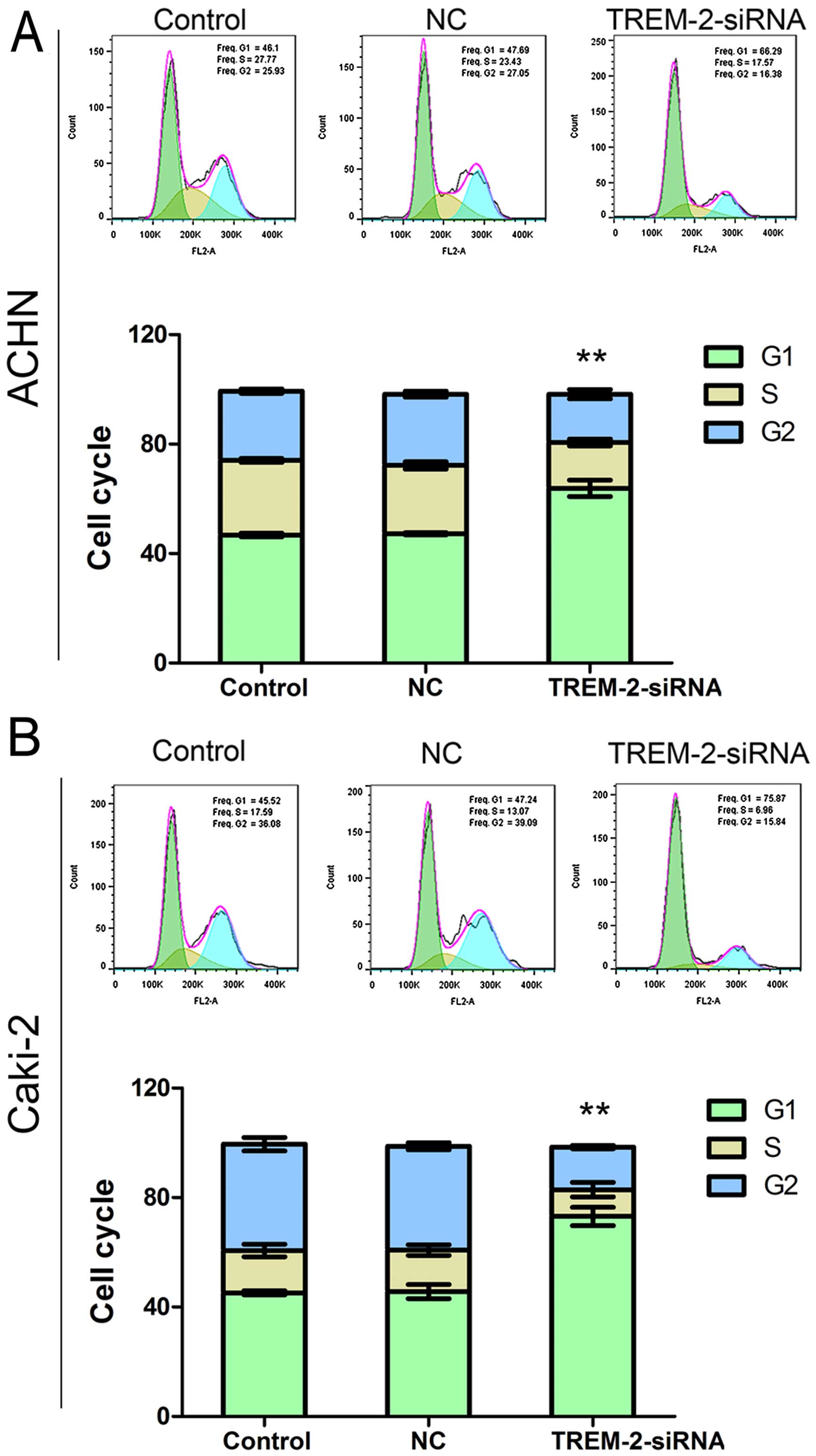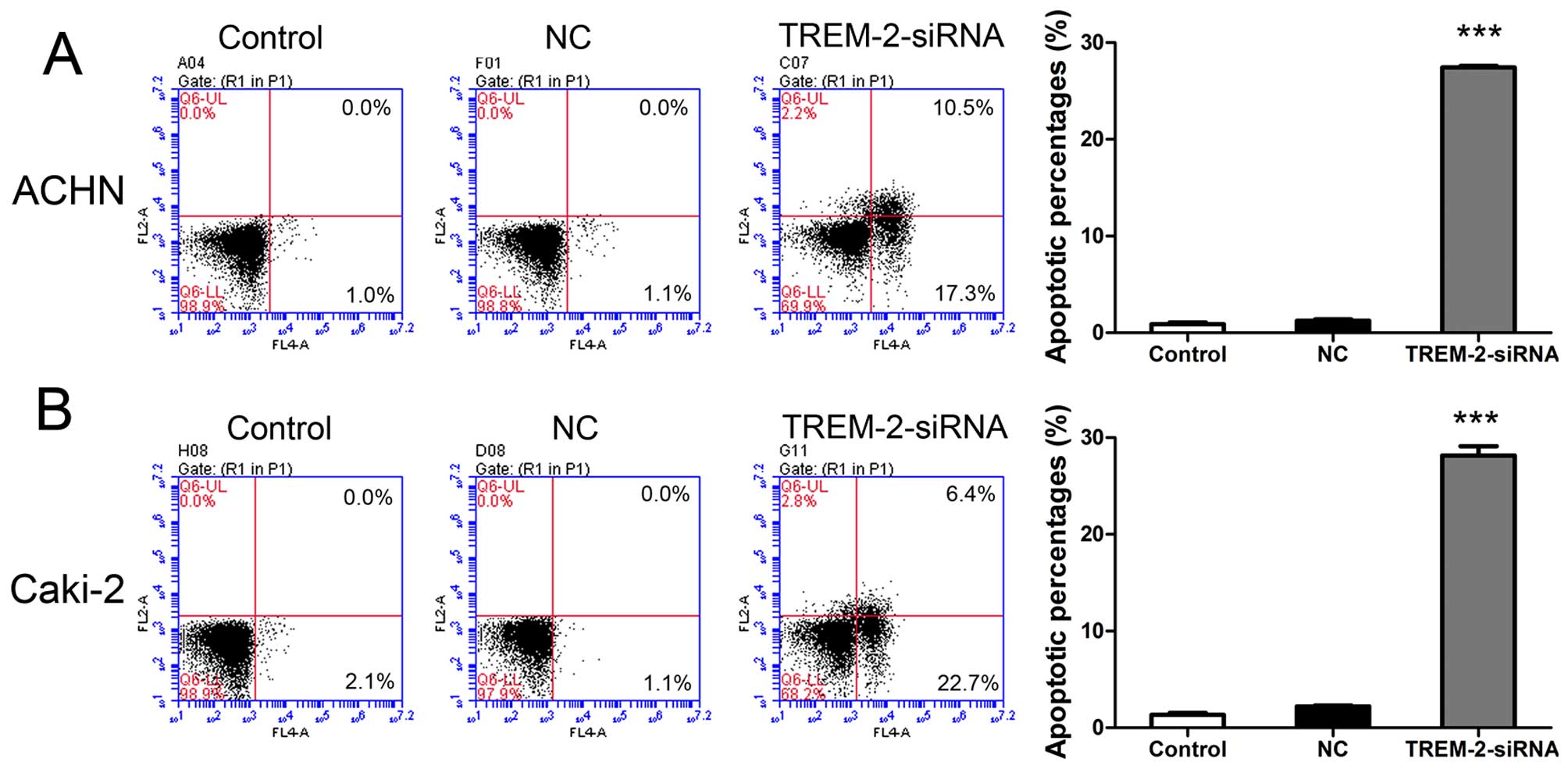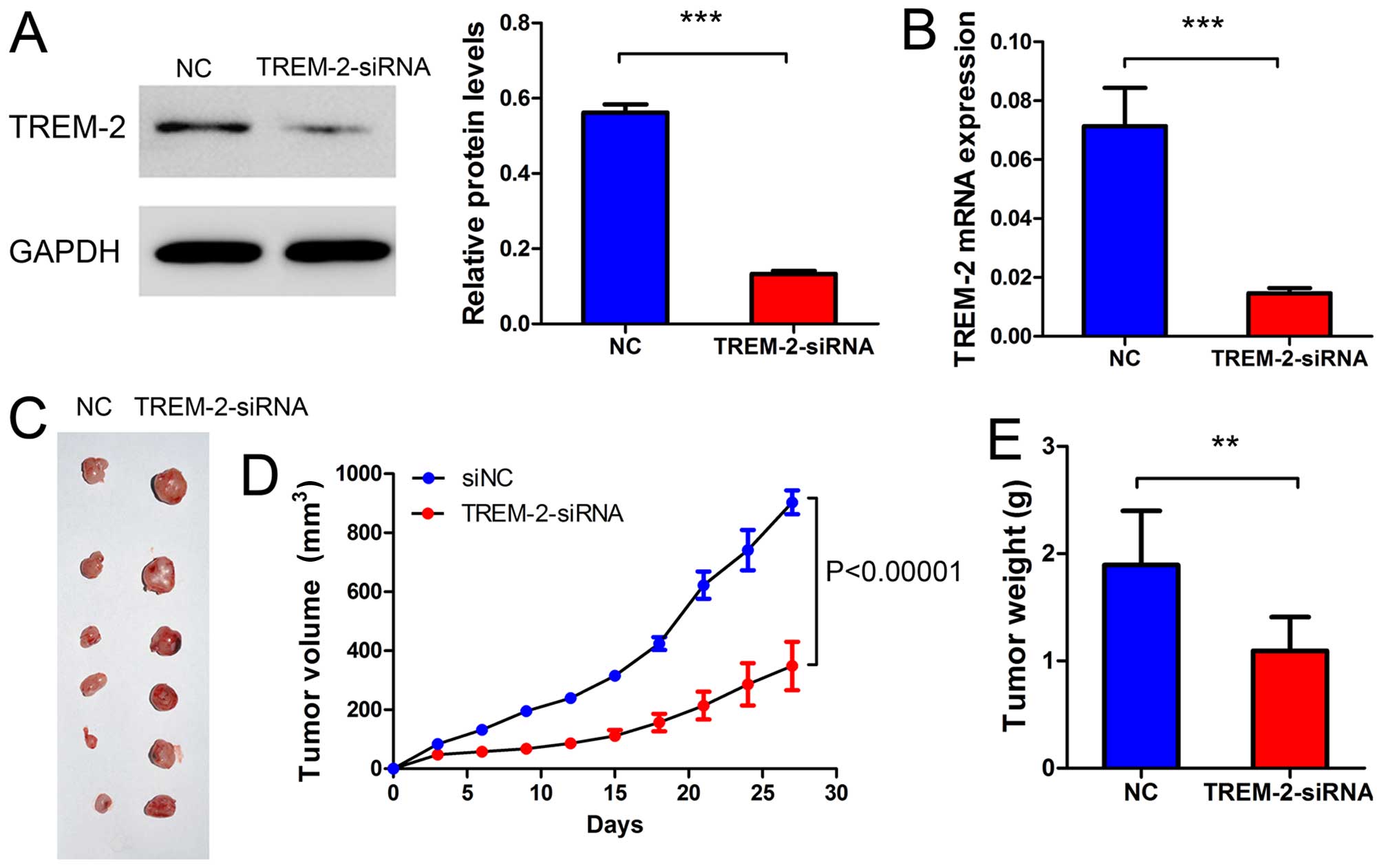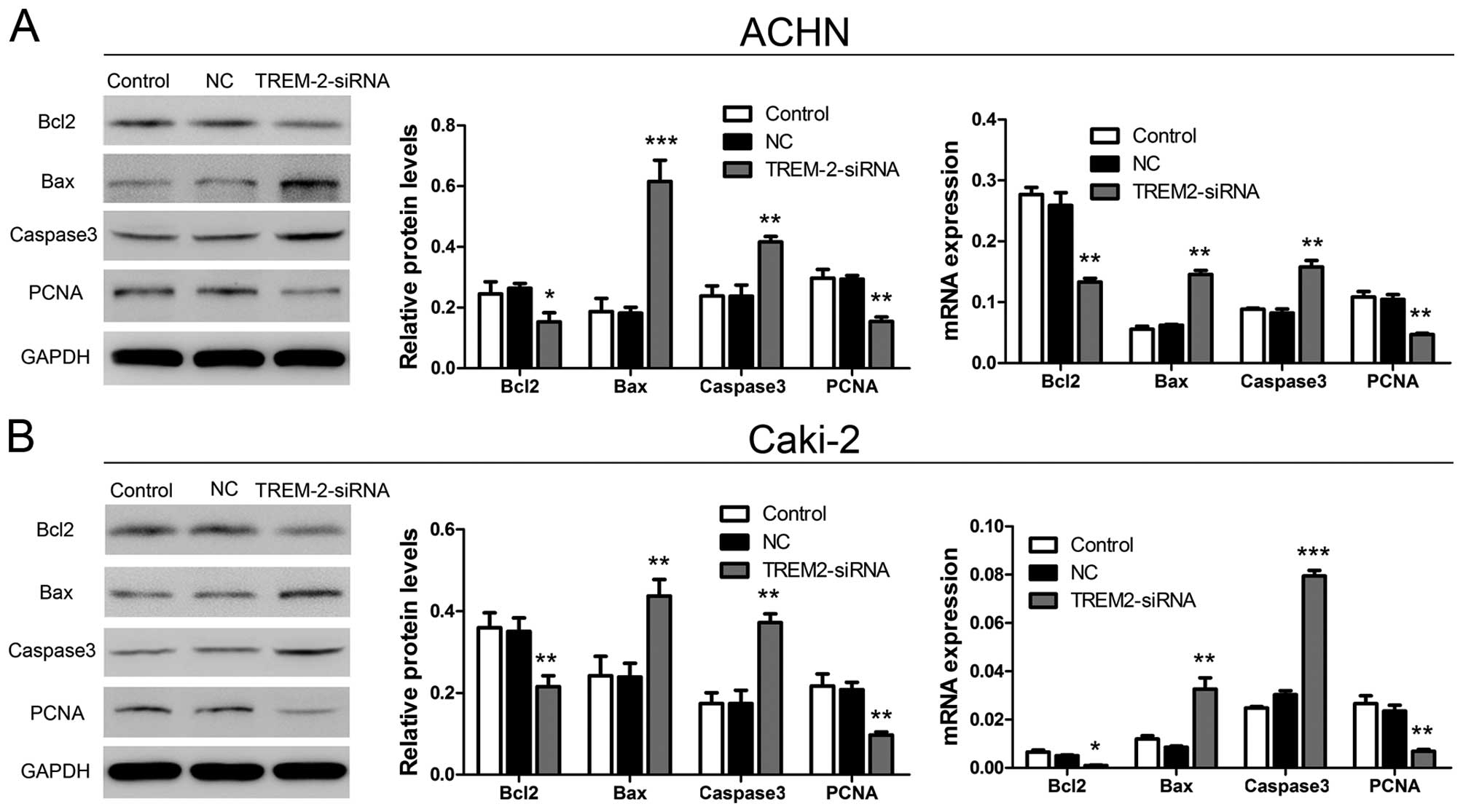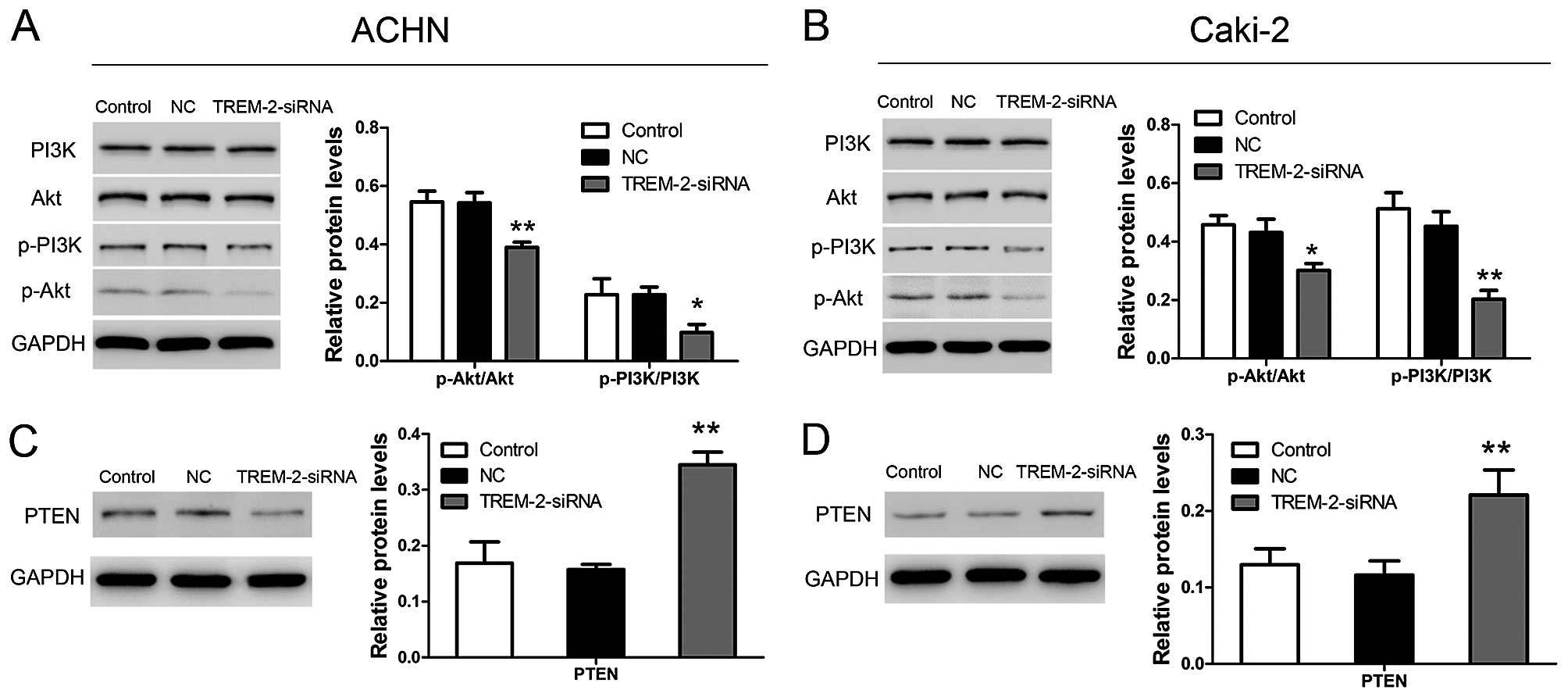Depletion of the triggering receptor expressed on myeloid cells 2 inhibits progression of renal cell carcinoma via regulating related protein expression and PTEN-PI3K/Akt pathway
- Authors:
- Published online on: October 19, 2016 https://doi.org/10.3892/ijo.2016.3740
- Pages: 2498-2506
Abstract
Introduction
Kidney cancer, one of the most common malignancies in genitourinary system, affects approximately 208,500 people all around the world each year. In addition, the global incidence of kidney cancer is continuously increasing (1). Renal cell carcinoma (RCC) is identified as the most common type of kidney cancer, which is responsible for approximately 90–95% of primary kidney cancer cases (2). RCC starts in the cells of the proximal renal tubular epithelium, with classic symptoms including haematuria, flank pain and an abdominal mass. Although smoking, NSAIDs medication and family history are suggested as risk factors, the exact pathogenies of RCC remain poorly understood (3,4). Besides, the therapy for RCC is still limited. Surgery is applied primarily in RCC treatment, as RCC is often insensitive to chemotherapy and radiotherapy. Whereas, surgery is not always efficient when the cancer has spread around the body. In recent years, target therapy has improved the treatment of RCC (5). Neutralization of vascular endothelial growth factor is proved to prolong the time to progression of disease in RCC patients. Thus, the research on potential targeting factors may light up the prospect for RCC treatment.
The transmembrane glycoproteins of triggering receptor expressed on myeloid cells (TREM) belong to the single immunoglobulin variable (IgV) domain receptor family (6). TREMs map to human chromosome 6p21.1 and encode TREM-1, TREM-2, TREM-4, TREM-5 and TREM-like genes in human. TREM-2 is encoded by a 1041-nucleotide long cDNA. This receptor consists of an extracellular domain, a transmembrane region and a short cytoplasmic tail (7,8). TREM-2 is involved in many biological processes (9). In bone remodeling, TREM-2 has been suggested to favor osteoclast differentiation and morphology (10). In immune responses, TREM-2 is associated with the upregulation of CD40, CD86, MHC class II in dendritic cells and the maturation of dendritic cells (11,12). TREM-2 also plays a role in suppressing the production of TNF and IL-6 and TLR signaling in macrophages (13,14). Moreover, TREM-2 is also involved in the pathology of some diseases. Related research proved that the defects in TREM-2 may be a cause of polycystic lipomembranous osteodysplasia with sclerosing leukeoncephalopathy (PLOSL) (15), and a rare missense mutation (rs75932628-T) in TREM-2 may confer an obvious risk of Alzheimer’s disease (16). Recently, TREM-2 is suggested functioning in human malignancies. Wang et al (17) have indicated that highly expressed TREM-2 promotes cell proliferation and invasion in glioma cells. Other studies also suggest that abnormally expressed TREM-2 may be associated with tumor immune evasion in lung cancer (18). Whereas, the effects of TREM-2 on RCC are still less known.
In the present study, we revealed the biological effects of TREM-2 on RCC cells for the first time. We found that the expression of TREM-2 is abnormally elevated in RCC tumor tissues. TREM-2 functioned as an oncogene in both RCC cell lines and tumor-bearing mouse model in vivo. The effect of TREM2 on RCC progression might be related to the regulation of apoptotic proteins and PTEN-PI3K/Akt pathway. Therefore, TREM-2 may provide a novel approach to the therapy for RCC.
Materials and methods
Tissue samples
Renal tumor tissues and adjacent normal tissues were collected from 40 patients with RCC treated at the Huadong Hospital, Fudan University. The tissues were stored at −80°C until being used. The study was approved by the Ethics Committee of Huadong Hospital, Fudan University. Informed and written consent were obtained from all patients according to the guidelines of the ethics committee.
Cell culture
Five RCC cell lines, Caki-1, Caki-2, ACHN, 786-0 and OS-RC-2 were purchased from the American Type Culture Collection (ATCC; Manassas, VA, USA). Cells were cultured in RMPI-1640 medium supplemented with 10% fetal bovine serum (FBS; Gibco), 100 U/ml penicillin and 100 μg/ml streptomycin. Cell culture was maintained at 37°C in a humidified 5% CO2 atmosphere.
RNA interference
To knock down the expression of TREM-2 in RCC cells, siRNA transfection was performed. siRNAs targeting three positions of human TREM-2 mRNA (NM_001271821.1; siRNA1: 125-147UCUUACUCUUUGUC ACAGA, siRNA1: 386–408 UUACGCUGCGGAAUCUACA and siRNA3: 591–613 GAGACACGUGAAGGAAGAU) were synthesized. A non-specific scramble siRNA sequence served as negative control (NC). siRNAs were transfected into RCC cells using Lipofectamine 2000 (Invitrogen) according to the manufacturer’s instructions. The following assays were performed at 48 h post-RNA interference.
CCK-8 assay
To analyze the cell proliferation, Caki-2 and ACHN cells (5×103) were seeded into 96-well plates and examined at 0, 24, 48 and 72 h after siRNA transfection using commercial Cell Counting kit (7seabitech) per the instructions of the manufacturer. Absorbance excited at 450 nm of reacted cells were detected to valuate cell growth.
Cell cycle assay
At 48 h after siRNA transfection, Caki-2 and ACHN cells were collected and fixed by 70% ethanol at −20°C for 2 h. After being washed with phosphate-buffered saline (PBS), the cells were incubated with propidudium iodide (PI; 0.05 mg/ml; Sigma-Aldrich) in the dark for 30 min. In addition, cell cycle assay was performed using flow cytometer (BD Biosciences, San Jose, CA, USA) and analyzed using FlowJo cell cycle analysis software.
Cell apoptosis assay
Caki-2 and ACHN cells were harvested at 48 h post-RNA interference. Cell apoptosis assay was performed using Annexin V apoptosis detection kit APC (eBioscience, San Diego, CA, USA). The cells double stained with Annexin V-fluorescein isothiocyanate (FITC) and PI were then examined by flow cytometer (BD Biosciences). At least 10,000 cells were obtained for each experiment.
Reverse transcription and real-time PCR (qRT-PCR)
Total RNA was extracted from RCC cells and tissue samples using TRIzol reagent (Invitrogen). Reverse transcription was performed via cDNA Synthesis kit (Fermentas, Waltham, MA, USA). qRT-PCR was processed using a standard SYBR-Green PCR kit (Fermentas). All the procedures were performed according to the manufacturer’s instructions. The cycle conditions were 10 min at 95°C, 40 cycles of 15 sec at 95°C and 45 sec at 60°C, 15 sec at 95°C, 1 min at 60°C followed by 15 sec at 95°C and 15 sec at 60°C. GAPDH served as internal control. The primer sequences were the following: TREM-2 NM_001271821.1): primer F, 5′-TGGCACTCTCACCATTACG-3′ and primer R, 5′-CCTCCCATCATCTTCCTTCAC-3′; Bax (NM_004324.3): primer F, 5′-AGCTGAGCGAGTGTCTCAAG-3′ and primer R, 5′-TGTCCAGCCCATGATGGTTC-3′; Bcl2 (NM_000633.2): primer F, 5′-AGACCGAA GTCCGCAGAACC-3′ and primer R, 5′-GAGACCACACTGC CCTGTTG-3′; PCNA (NM_002592.2): primer F, 5′-GCCTGACAAATGCTTGCTGAC-3′ and primer R, 5′-TTGAGTGCCTCCAACACCTTC-3′; caspase-3 (NM_004346.3): primer F, 5′-AACTGGACGTGGCATTGAG-3′ and primer R, 5′-ACAAAGCGACTGGATGAACC-3′; GAPDH (NM_001256799.1): primer F, 5′-CACCCACTCCTCCACCTTTG-3′ and primer R, 5′-CCACCACCCTGTTGCTGTAG-3′.
Western blotting
Tissue samples were collected and put into homogenizer to grind into tissue homogenate. Treated and untreated RCC cells were harvested and washed twice with PBS. Then, tissue homogenate and cells were disrupted in a radio-immunoprecipitation assay lysis buffer. After protein normalization, tissue and cell samples were separated in SDS-PAGE and transferred to a nitrocellulose membrane. The blots were then incubated with appropriate primary and secondary antibodies following blocked with 5% skim milk. Visualization was performed using the enhanced chemiluminescence (ECL; Millipore, Billerica, MA, USA). The antibody list was as follows: TREM-2 (1:800, Ab86491; Abcam, Cambridge, MA, USA), PCNA (1:1,000, #13110; Cell Signaling Technology Danvers, MA, USA), Bax (1:300, Sc-493; Santa Cruz Biotechnology, Santa Cruz, CA, USA), Bcl2 (1:300, Sc-492; Santa Cruz Biotechnology), caspase-3 (1:500, Ab44976; Abcam), PTEN (1:1,000, #9188; Cell Signaling Technology), PI3K (1:1,000, Ab189403; Abcam), p-PI3K (1:1,000, Ab182651; Abcam), Akt (1:1,000, #9272; Cell Signaling Technology), p-Akt (1:1,000, #9271, Cell Signaling Technology), GAPDH (1:1,500, #5174; Cell Signaling Technology) and HRP-labeled secondary antibodies (1:1,000, A0208, A0181, A0216; Beyotime Institute of Biotechnolgy, Haimen, China).
Nude mouse xenograft model
Animal experiments were approved and performed per the guidelines of Animal Care and Use Committee of Huadong Hospital, Fudan University (Shanghai, China). Twelve BALB/c nude mice aged 4-weeks (SLAC animal) were maintained under specific pathogen-free conditions using a laminar air-flow rack. All the mice were fed with sterilized food and autoclaved water. Injection was performed as previously described (19). Briefly, after one week of acclimatization, 12 nude mice were divided into two groups, NC group and siRNA group (n=6/group) randomly, and subcutaneously injected with ACHN cells transfected with NC-siRNA and TREM-2-siRNA (2×106) to the armpit of nude mouse, respectively. After 1 week of tumorigenesis, the shortest and longest diameter of the tumor were measured with calipers every 3 days, and tumor volume (mm3) was calculated using the following standard formula: (the shortest diameter)2 × (the longest diameter) × 0.5. On day 34 post-injection, the mice were sacrificed by cervical dislocation and the tumors were harvested. The wet weights of each tumor were examined. During the experimental procedure, all mice were monitored every 2 days. None of the mice died prior to the experimental endpoint.
Statistical analysis
At least 3 independent experiments were performed in every assay. Data analysis used GraphPad Prism software. Data are expressed as mean (± SD) and analyzed with t-test for multiple comparisons. P<0.05 was considered to indicate a statistically significant result.
Results
TREM-2 expression is elevated in RCC tissues
To profile the expression pattern of TREM-2 in RCC, we analyzed the mRNA and protein expression of TREM-2 in tumor and adjacent normal tissues from 40 patients with RCC using qRT-PCR and western blot analysis. As Fig. 1 shows, both mRNA and protein levels of TREM2 were significantly higher in tumor tissues than adjacent normal tissues. These data indicated that the expression of TREM-2 was abnormally elevated in RCC tumor tissues.
TREM-2 knockdown via RNA interference
We then examined TREM-2 expression level in five RCC cell lines, including Caki-1, Caki-2, ACHN, 786-0 and OS-RC-2, using qRT-PCR and western blot analysis. We found that TREM2 was highly expressed in ACHN and Caki-2 cell lines as comparing to other three cell lines (Fig. 2A and B). In addition, we employed these two RCC cell lines to carry out the following experiments. To further analyzed the biological functions of TREM-2 in RCC, TREM-2 expression was silenced in ACHN and Caki-2 cells using RNA interference. The results of qRT-PCR showed that, the mRNA level of TREM-2 was significantly suppressed after siRNA transfection. In addition, the siRNA2 (targeting position 386–408: UUACGCUGCGGAAUCUACA) silenced TREM-2 expression more effectively as comparing to the other two siRNAs. Thus, siRNA2 was selected as TREM-2-siRNA transfected into cancer cells for the following assays. The western blot data also confirmed that siRNA2 decreased the protein level of TREM-2 in two RCC cell lines (Fig. 2C and D).
Depletion of TREM-2 inhibits cell proliferation in RCC cell lines
We analyzed the cell growth of ACHN and Caki-2 at 0, 24, 48 and 72 h post-RNA interference using CCK-8 assay. As shown in Fig. 3, obvious decrease of cell growth was detected in both ACHN and Caki-2 cells at 48 and 72 h after siRNA transfection. Whereas, the cell proliferation was not affected in the NC group. These data suggested that knockdown of TREM-2 might suppress cell growth in RCC progression.
TREM-2 knockdown induces G1 phase arrest in RCC cell lines
As silencing TREM2 inhibited cell growth in RCC, we analyzed the effects of TREM-2 on the cell cycle progress in ACHN and Caki-2 cells sequentially. The RCC cells were stained by PI at 48 h post-RNA interference, and the cell cycle was examined by flow cytometry. As shown in Fig. 4, proportion of G1 phase was remarkably increased in siRNA-TREM-2 group than in the NC group, with increased ratios: 35.13 and 60.30% in ACHN and Caki-2, respectively. These results indicated that, silencing the expression of TREM-2 might inhibit cell cycle progress via inducing THE G1 phase arrest.
Silencing TREM-2 causes cell apoptosis in RCC cell lines
We analyzed the effects of TREM-2 on cell apoptosis in ACHN and Caki-2 cells at 48 h after siRNA transfection. The cells were double stained by Annexin V-FITC and PI, and examined using flow cytometry. As illustrated in Fig. 5, ~22-fold increase and 13-fold increase of cell apoptosis was examined in ACHN and Caki-2 cells of siRNA groups as comparing to NC groups. The data showed that knockdown of TREM-2 induced significant cell apoptosis in RCC cell lines.
Silencing TREM-2 inhibits xenografted ACHN tumor development in nude mice
We then examined whether TREM-2 silenced in RCC cells could inhibit tumor growth in vivo. The ACHN cells transfected with NC-siRNA or TREM-2-siRNa were subcutaneously injected into nude mice, respectively. Tumor volumes were measured for 27 days. The weight of tumors were measured on day 34. As shown in Fig. 6A–C, the mRNA expression and protein level of TREM-2 were significantly decreased in TREM-2-siRNA group compared with NC group. As shown in Fig. 6C–E, both the volume and the weight of RCC tumors were obviously decreased after TREM-2-siRNA transfection. These results implicated that TREM-2 knockdown might inhibit the tumor development of RCC in vivo.
Silencing TREM-2 altered endogenous expression of proteins related to apoptosis and the cell cycle in RCC cell lines
As described above, TREM-2 might act as a promoter in cell proliferation through inducing cell cycle progress and inhibiting cell apoptosis. We then examined four related protein levels, including Bcl2, Bax, caspase-3 and PCNA, using qRT-PCR and western blot analysis at 48 h post-RNA interference. As shown in Fig. 7, mRNA expression of Bcl2 (decreased ratios: ACHN, 48.55% and Caki-2, 80.47%) and PCNA (decreased ratios: ACHN, 55.11% and Caki-2, 69.58%) were obviously decreased after TREM-2 knockdown. Whereas, the mRNA expression of Bax (increased ratios: ACHN, 134.16% and Caki-2, 172.83%) and caspase-3 (increase ratios: ACHN, 91.77% and Caki-2, 162.50%) were significantly increased in siRNA-TREM-2 groups compared to NC groups. The same results were also examined by western blot analysis. The protein levels of Bcl-2 and PCNA were reduced, while the protein levels of Bax and caspase-3 were elevated after siRNA transfection. The decreased ratios of Bcl2 and PCNA protein levels were 41.94 and 47.39% in ACHN, 38.54 and 53.59% in Caki-2, respectively. The increased ratios of Bax and caspase-3 protein levels were 239.18 and 75.45% in ACHN, and 82.99 and 113.98% in Caki-2, respectively.
Depletion of TREM-2 inactivates PTEN-PI3K/Akt signaling pathway in RCC cell lines
To reveal the functional mechanisms of TREM-2 in cell growth, we analyzed the PTEN-PI3K/Akt signaling pathway using western blot analysis. As Fig. 8A and B show, TREM-2 knockdown significantly increased the protein level of PTEN in ACHN and Caki-2 cells. Depletion of TREM-2 inhibited phoshoprylation of PI3K and Akt in both cell lines (Fig. 8C and D). These data suggested that TREM-2 knockdown inhibited the activation of PI3K/AKT pathway via upregulating the PTEN level in RCC cell lines.
Discussion
Immunotherapy and targeted therapy have recently provided new insights into the treatment of RCC. Research on novel targeting factors still remains urgent. TREM-1, a member of TREM family, has been suggested to be involved in progression of certain human malignancies. Liao et al (20) has proved that TREM-1 is related to the aggressive tumor behavior and has potential value as a prognostic factor for hepatocellular carcinoma. TREM-1 is upregulated in macrophages and is associated with cancer recurrence and poor survival of patients with lung cancer (21,22). TREM-2 is also suggested to act as an oncogene in glioma (17). Moreover, TREM-2 is proven to promote tumor immune evasion in lung cancer cells (18). Inspired by the association between TREMs and human cancers, we sought to reveal the role of TREM-2 in RCC. We found that the expression of TREM-2 is remarkably facilitated in tumor tissues compared with the adjacent normal tissues of patients with RCC. It indicated that elevated TREM-2 might play a role in the RCC progression.
Then, we knocked down the TREM-2 expression in selected RCC cancer cell lines via RNA interference. In addition, we examined effects of TREM-2 depletion on cell proliferation, apoptosis and cell cycle in ACHN and Caki-2. The data showed that TREM-2 knockdown significantly inhibited cell growth, and induced cell apoptosis in two RCC cell lines. Similar results were also found in research by Wang et al (17). In their previous study, silencing TREM-2 suppressed cell proliferation and promotes cell apoptosis in glioma cells. In cell cycle assay, we found that depletion of TREM-2 induced arrest in G1 phase of cell cycle in RCC cells. In vivo, the data affirmed that knockdown of TREM-2 inhibited tumorigenesis of RCC cells. The above results illustrated that TREM-2 might function as an oncogene in RCC development.
To confirm the functional mechanisms of TREM-2 in RCC cells, we analyzed the protein levels and mRNA expression of factors related to apoptosis and cell cycle using western blot and qRT-PCR analysis. We found that in ACHN and Caki-2 cells, both mRNA expression and protein levels of Bcl2 and PCNA were obviously decreased post-RNA interference. Whereas, expression of Bax and caspase-3 were elevated in TREM-2-siRNA groups as comparing to NC groups in two RCC cell lines. Bcl2 belongs to the antiapoptotic Bcl2 family, which acts to prevent or delay cell death. Previous studies indicate that increased expression of Bcl2 in RCC may decrease the levels of apoptosis and promote resistant to treatment (23,24). PCNA, a progressivity factor for DNA polymerase δ, is essential for DNA replication (25,26). In addition, suppression of PCNA may cause G1 phase arrest in cell cycle and promote cell death in cancer cells (27). Bax and caspase-3 act as promoters in cell apoptosis. Especially, activation of caspase-3 plays a central role in the execution-phase of cell apoptosis (28). Thus, the results of this study implicated that TREM-2 affects cell growth, apoptosis and cell cycle through regulating the mRNA expression and intracellular levels of related proteins.
Finally, we analyzed the effects of TREM-2 on PTEN-PI3K/Akt pathway. PI3K is a lipid kinase and generated PI(3,4,5)P3, which is an essential second messenger in translocation of Akt to plasma membrane. Activated Akt plays a pivotal role in fundamental cellular functions (29,30). The activation of PI3K/Akt pathway has been suggested involved in many kinds of human tumors, such as breast, lung cancer and leukemia (31–33). PI3K/Akt pathway also plays a key role in RCC. Activation of PI3K/Akt is associated with the decrease of the survival rate in RCC (34). Research has proven that certain anticancer agents, such as Klotho and β-elemene, inhibit the tumor progression through suppressing PI3K/Akt signaling in RCC (35–38). TREM-2 has been proven as an activator in PI3K/Akt signaling pathway. Elevated TREM-2 can mediate bacterial killing via activating PI3K/Akt pathway (39,40). PTEN is identified as a tumor suppressor that is mutated in a large number of cancers at high frequency (41). PTEN acts as a key negative regulator in the alternations of PI3K/Akt through decreasing the intracellular level of PI(3,4,5)P3 in cells (42). In addition, the disturbed expression and function of PTEN have been examined in both human cancer cell lines and human malignancies (43–45). Research has implicated that inhibition of PTEN may cause permanent activation of the PI3K/Akt pathway (46). In the present study, we found that TREM-2 knockdown significantly inactivated the PI3K/Akt pathway by downregulating the intracellular protein levels of p-PI3K and p-Akt, and increased the intracellular protein level of PTEN in two RCC cell lines. Therefore, the data suggested that TREM-2 might act as a regulator of PI3K/Akt through altering the PTEN level in RCC.
In conclusion, this study first revealed the role of TREM-2 in RCC progression. We found that TREM-2 is abnormally elevated in RCC tissues. Knockdown of TREM-2 obviously inhibited cell proliferation, induced cell apoptosis and G1 phase arrest in RCC cells. The in vivo experiments also confirmed that depletion of TREM-2 suppressed the tumor development of RCC. Moreover, the oncogene functional effects of TREM-2 might be caused by its regulation of related proteins and PTEN-PI3K/Akt pathway. Therefore, TREM-2 may be considered as a potential therapeutic target in the treatment of RCC.
References
|
Yi Z, Fu Y, Zhao S, Zhang X and Ma C: Differential expression of miRNA patterns in renal cell carcinoma and nontumorous tissues. J Cancer Res Clin Oncol. 136:855–862. 2010. View Article : Google Scholar | |
|
Rini BI, Campbell SC and Escudier B: Renal cell carcinoma. Lancet. 373:1119–1132. 2009. View Article : Google Scholar : PubMed/NCBI | |
|
Cheungpasitporn W, Thongprayoon C, O’Corragain OA, Edmonds PJ, Ungprasert P, Kittanamongkolchai W and Erickson SB: The risk of kidney cancer in patients with kidney stones: A systematic review and meta-analysis. QJM. 108:205–212. 2014. View Article : Google Scholar : PubMed/NCBI | |
|
Ljungberg B, Campbell SC, Choi HY, Jacqmin D, Lee JE, Weikert S and Kiemeney LA: The epidemiology of renal cell carcinoma. Eur Urol. 60:615–621. 2011. View Article : Google Scholar : PubMed/NCBI | |
|
Singer EA, Gupta GN, Marchalik D and Srinivasan R: Evolving therapeutic targets in renal cell carcinoma. Curr Opin Oncol. 25:273–280. 2013.PubMed/NCBI | |
|
Allcock RJ, Barrow AD, Forbes S, Beck S and Trowsdale J: The human TREM gene cluster at 6p21.1 encodes both activating and inhibitory single IgV domain receptors and includes NKp44. Eur J Immunol. 33:567–577. 2003. View Article : Google Scholar : PubMed/NCBI | |
|
Klesney-Tait J, Turnbull IR and Colonna M: The TREM receptor family and signal integration. Nat Immunol. 7:1266–1273. 2006. View Article : Google Scholar : PubMed/NCBI | |
|
Whittaker GC, Orr SJ, Quigley L, Hughes L, Francischetti IM, Zhang W and McVicar DW: The linker for activation of B cells (LAB)/non-T cell activation linker (NTAL) regulates triggering receptor expressed on myeloid cells (TREM)-2 signaling and macrophage inflammatory responses independently of the linker for activation of T cells. J Biol Chem. 285:2976–2985. 2010. View Article : Google Scholar : | |
|
Paradowska-Gorycka A and Jurkowska M: Structure, expression pattern and biological activity of molecular complex TREM-2/DAP12. Hum Immunol. 74:730–737. 2013. View Article : Google Scholar : PubMed/NCBI | |
|
Filbert EA: Investigations of mechanisms involved in LPS-stimulated osteoclastogenesis. University of Connecticut, School of Dental Medicine; SoDM Masters Theses, Paper 155. 2007 | |
|
Sharif O and Knapp S: From expression to signaling: Roles of TREM-1 and TREM-2 in innate immunity and bacterial infection. Immunobiology. 213:701–713. 2008. View Article : Google Scholar : PubMed/NCBI | |
|
Tomasello E, Desmoulins P-O, Chemin K, Guia S, Cremer H, Ortaldo J, Love P, Kaiserlian D and Vivier E: Combined natural killer cell and dendritic cell functional deficiency in KARAP/DAP12 loss-of-function mutant mice. Immunity. 13:355–364. 2000. View Article : Google Scholar : PubMed/NCBI | |
|
Helming L, Tomasello E, Kyriakides TR, Martinez FO, Takai T, Gordon S and Vivier E: Essential role of DAP12 signaling in macrophage programming into a fusion-competent state. Sci Signal. 1:ra112008. View Article : Google Scholar : PubMed/NCBI | |
|
Turnbull IR, Gilfillan S, Cella M, Aoshi T, Miller M, Piccio L, Hernandez M and Colonna M: Cutting edge: TREM-2 attenuates macrophage activation. J Immunol. 177:3520–3524. 2006. View Article : Google Scholar : PubMed/NCBI | |
|
Paloneva J, Manninen T, Christman G, Hovanes K, Mandelin J, Adolfsson R, Bianchin M, Bird T, Miranda R, Salmaggi A, et al: Mutations in two genes encoding different subunits of a receptor signaling complex result in an identical disease phenotype. Am J Hum Genet. 71:656–662. 2002. View Article : Google Scholar : PubMed/NCBI | |
|
Guerreiro R, Wojtas A, Bras J, Carrasquillo M, Rogaeva E, Majounie E, Cruchaga C, Sassi C, Kauwe JS, Younkin S, et al; Alzheimer Genetic Analysis Group. TREM2 variants in Alzheimer’s disease. N Engl J Med. 368:117–127. 2013. View Article : Google Scholar | |
|
Wang XQ, Tao BB, Li B, Wang XH, Zhang WC, Wan L, Hua XM and Li ST: Overexpression of TREM2 enhances glioma cell proliferation and invasion: A therapeutic target in human glioma. Oncotarget. 7:2354–2366. 2016. | |
|
Yao Y, Li H, Wang Y and Zhou J: Triggering receptor expressed on myeloid cells-2 (TREM-2) elicited by lung cancer cells to facilitate tumor immune evasion. J Clin Oncol. 31(Suppl): 220542013. | |
|
Chen Y, Guo Y, Yang H, Shi G, Xu G, Shi J, Yin N and Chen D: TRIM66 overexpresssion contributes to osteosarcoma carcinogenesis and indicates poor survival outcome. Oncotarget. 6:23708–23719. 2015. View Article : Google Scholar : PubMed/NCBI | |
|
Liao R, Sun TW, Yi Y, Wu H, Li YW, Wang JX, Zhou J, Shi YH, Cheng YF, Qiu SJ, et al: Expression of TREM-1 in hepatic stellate cells and prognostic value in hepatitis B-related hepatocellular carcinoma. Cancer Sci. 103:984–992. 2012. View Article : Google Scholar : PubMed/NCBI | |
|
Ho CC, Liao WY, Wang CY, Lu YH, Huang HY, Chen HY, Chan WK, Chen HW and Yang PC: TREM-1 expression in tumor-associated macrophages and clinical outcome in lung cancer. Am J Respir Crit Care Med. 177:763–770. 2008. View Article : Google Scholar | |
|
Yuan Z, Mehta HJ, Mohammed K, Nasreen N, Roman R, Brantly M and Sadikot RT: TREM-1 is induced in tumor associated macrophages by cyclo-oxygenase pathway in human non-small cell lung cancer. PLoS One. 9:e942412014. View Article : Google Scholar : PubMed/NCBI | |
|
Gobé G, Rubin M, Williams G, Sawczuk I and Buttyan R: Apoptosis and expression of Bcl-2, Bcl-XL, and Bax in renal cell carcinomas. Cancer Invest. 20:324–332. 2002. View Article : Google Scholar : PubMed/NCBI | |
|
Sejima T and Miyagawa I: Expression of bcl-2, p53 oncoprotein, and proliferating cell nuclear antigen in renal cell carcinoma. Eur Urol. 35:242–248. 1999. View Article : Google Scholar : PubMed/NCBI | |
|
Fisher PA, Moutsiakis DL, McConnell M, Miller H and Mozzherin DJ: A single amino acid change (E85K) in human PCNA that leads, relative to wild type, to enhanced DNA synthesis by DNA polymerase δ past nucleotide base lesions (TLS) as well as on unmodified templates. Biochemistry. 43:15915–15921. 2004. View Article : Google Scholar : PubMed/NCBI | |
|
Zhang P, Sun Y, Hsu H, Zhang L, Zhang Y and Lee MY: The interdomain connector loop of human PCNA is involved in a direct interaction with human polymerase δ. J Biol Chem. 273:713–719. 1998. View Article : Google Scholar : PubMed/NCBI | |
|
Pleschke JM, Kleczkowska HE, Strohm M and Althaus FR: Poly(ADP-ribose) binds to specific domains in DNA damage checkpoint proteins. J Biol Chem. 275:40974–40980. 2000. View Article : Google Scholar : PubMed/NCBI | |
|
Cohen GM: Caspases: The executioners of apoptosis. Biochem J. 326:1–16. 1997. View Article : Google Scholar : PubMed/NCBI | |
|
Datta SR, Brunet A and Greenberg ME: Cellular survival: A play in three Akts. Genes Dev. 13:2905–2927. 1999. View Article : Google Scholar : PubMed/NCBI | |
|
Vivanco I and Sawyers CL: The phosphatidylinositol 3-Kinase AKT pathway in human cancer. Nat Rev Cancer. 2:489–501. 2002. View Article : Google Scholar : PubMed/NCBI | |
|
Fry MJ: Phosphoinositide 3-kinase signalling in breast cancer: How big a role might it play? Breast Cancer Res. 3:304–312. 2001. View Article : Google Scholar : PubMed/NCBI | |
|
Lin X, Böhle AS, Dohrmann P, Leuschner I, Schulz A, Kremer B and Fändrich F: Overexpression of phosphatidylinositol 3-kinase in human lung cancer. Langenbecks Arch Surg. 386:293–301. 2001. View Article : Google Scholar : PubMed/NCBI | |
|
Martínez-Lorenzo MJ, Anel A, Monleón I, Sierra JJ, Piñeiro A, Naval J and Alava MA: Tyrosine phosphorylation of the p85 subunit of phosphatidylinositol 3-kinase correlates with high proliferation rates in sublines derived from the Jurkat leukemia. Int J Biochem Cell Biol. 32:435–445. 2000. View Article : Google Scholar : PubMed/NCBI | |
|
Merseburger AS, Hennenlotter J, Kuehs U, Simon P, Kruck S, Koch E, Stenzl A and Kuczyk MA: Activation of PI3K is associated with reduced survival in renal cell carcinoma. Urol Int. 80:372–377. 2008. View Article : Google Scholar : PubMed/NCBI | |
|
Zhu Y, Xu L, Zhang J, Xu W, Liu Y, Yin H, Lv T, An H, Liu L, He H, et al: Klotho suppresses tumor progression via inhibiting PI3K/Akt/GSK3β/Snail signaling in renal cell carcinoma. Cancer Sci. 104:663–671. 2013. View Article : Google Scholar : PubMed/NCBI | |
|
Zhan YH, Liu J, Qu XJ, Hou KZ, Wang KF, Liu YP and Wu B: β-Elemene induces apoptosis in human renal-cell carcinoma 786–0 cells through inhibition of MAPK/ERK and PI3K/Akt/mTOR signalling pathways. Asian Pac J Cancer Prev. 13:2739–2744. 2012. View Article : Google Scholar | |
|
Li H, Zeng J and Shen K: PI3K/AKT/mTOR signaling pathway as a therapeutic target for ovarian cancer. Arch Gynecol Obstet. 290:1067–1078. 2014. View Article : Google Scholar : PubMed/NCBI | |
|
Roy SK, Srivastava RK and Shankar S: Inhibition of PI3K/AKT and MAPK/ERK pathways causes activation of FOXO transcription factor, leading to cell cycle arrest and apoptosis in pancreatic cancer. J Mol Signal. 5:102010. View Article : Google Scholar : PubMed/NCBI | |
|
Sun M, Zhu M, Chen K, Nie X, Deng Q, Hazlett LD, Wu Y, Li M, Wu M and Huang X: TREM-2 promotes host resistance against Pseudomonas aeruginosa infection by suppressing corneal inflammation via a PI3K/Akt signaling pathway. Invest Ophthalmol Vis Sci. 54:3451–3462. 2013. View Article : Google Scholar : PubMed/NCBI | |
|
Zhu M, Li D, Wu Y, Huang X and Wu M: TREM-2 promotes macrophage-mediated eradication of Pseudomonas aeruginosa via a PI3K/Akt pathway. Scand J Immunol. 79:187–196. 2014. View Article : Google Scholar : PubMed/NCBI | |
|
Myers MP and Tonks NK: PTEN: Sometimes taking it off can be better than putting it on. Am J Hum Genet. 61:1234–1238. 1997. View Article : Google Scholar : PubMed/NCBI | |
|
Maehama T and Dixon JE: The tumor suppressor, PTEN/MMAC1, dephosphorylates the lipid second messenger, phosphatidylinositol 3,4,5-trisphosphate. J Biol Chem. 273:13375–13378. 1998. View Article : Google Scholar : PubMed/NCBI | |
|
Eng C: PTEN: One gene, many syndromes. Hum Mutat. 22:183–198. 2003. View Article : Google Scholar : PubMed/NCBI | |
|
Muñoz J, Lázcoz P, Inda MM, Nistal M, Pestaña A, Encío IJ and Castresana JS: Homozygous deletion and expression of PTEN and DMBT1 in human primary neuroblastoma and cell lines. Int J Cancer. 109:673–679. 2004. View Article : Google Scholar : PubMed/NCBI | |
|
Nassif NT, Lobo GP, Wu X, Henderson CJ, Morrison CD, Eng C, Jalaludin B and Segelov E: PTEN mutations are common in sporadic microsatellite stable colorectal cancer. Oncogene. 23:617–628. 2004. View Article : Google Scholar : PubMed/NCBI | |
|
Osaki M, Oshimura M and Ito H: PI3K-Akt pathway: Its functions and alterations in human cancer. Apoptosis. 9:667–676. 2004. View Article : Google Scholar : PubMed/NCBI |



